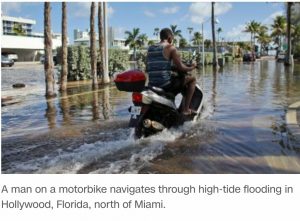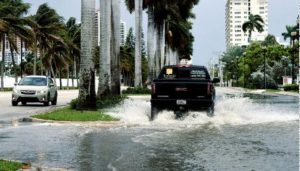
As rescue and recovery teams dig through the rubble of the collapsed condo building in Surfside, Florida, scientists and engineers are starting to consider what could have possibly caused the deadly tragedy.
Among a long list of hypotheses: climate change. Sea level rise, higher storm surges and more frequent high-tide flooding are deteriorating coastal infrastructure above and below ground.
Officials are still very early in their investigation into what caused the collapse, and initial signs point to potential issues at the base of the building, perhaps in its foundation, columns or underground parking garage.
But some engineers are considering whether increasing exposure to saltwater could have played a role in weakening the building’s foundation or internal support system.
At the very least, experts say even the possibility should be a wake-up call to vulnerable communities across the United States: Climate change isn’t a far-future threat; it’s happening now, and with potentially deadly consequences.
Florida is one of the states most vulnerable to climate change. Sea level in the Miami area, including Surfside, has risen roughly 7 to 8 inches since Champlain Towers South was built 40 years ago, according to Brian McNoldy, a climate and weather researcher at the University of Miami.
McNoldy has lived in Miami for more than nine years and has seen the impact of high-tide flooding, also referred to as nuisance flooding or “King Tide” floods.
“There are days where I have to adjust my route to work, because the route that I might normally take is inches of saltwater,” he told CNN. “And I don’t want to drive my car through it.”

Virginia Key, a barrier island off the Miami coast, experienced 9 days of high-tide flooding in 2019, according to the National Oceanic and Atmospheric Administration, which was an annual record for the location.
“Some low-lying places that maybe didn’t use to flood are starting to now, and places that maybe always did have some issues during exceptionally high-tides have even worse issues now,” McNoldy told CNN.
William Espinosa, a former maintenance manager at the Champlain Towers South building from 1995 to 2000, was concerned about the amount of saltwater that made its way into the building’s underground garage, according to CNN-affiliate WFOR.
“Any time that we had high tides away from the ordinary, any King Tide or anything like that, we would have a lot of saltwater come in through the bottom of the of the foundation,” Espinosa told WFOR. “But it was so much water, all the time, that the pumps never could keep up with it.”
“I’m talking about a foot, sometimes two feet of water in the bottom of the parking lot, the whole parking lot,” he added.
In a letter obtained by CNN’s “Erin Burnett OutFront,” Champlain Towers South Board President Jean Wodnicki wrote to residents in April describing the building’s worsening decay since a 2018 engineering report warned of design flaws and deteriorating infrastructure.
“The observable damage such as in the garage has gotten significantly worse since the initial (2018) inspection,” Wodnicki wrote. “The concrete deterioration is accelerating. The roof situation got much worse, so extensive roof repairs had to be incorporated.”
Hamed Moftakhari, a professor of civil and environmental engineering at the University of Alabama, said that South Florida experiences nuisance flooding, or high-tide flooding, on a regular basis. Higher sea levels increase flood hazards and vulnerability, exposing critical infrastructure to saltwater.
Higher sea level increases the amount of saltwater building foundations are exposed to, Moftakhari told CNN. “Infrastructure like roads and foundations are not designed to be inundated by saltwater a couple of hours a day.”
Ben Schafer, a structural engineer at Johns Hopkins University said sea-level rise and saltwater intrusion — where underground seawater moves farther inland — typically threatens older coastal buildings like Champlain Towers South.
“The life of the structure would be greatly shortened,” Schafer told CNN. “It’s a corrosive environment. It’s not favorable for concrete or steel, which are your primary building materials.”
Eighteen other coastal locations in addition to the Miami region broke records for high-tide flooding in 2019, including Annapolis, Maryland, where 18 days of high water disrupted transportation and parking in the downtown area, according to NOAA. Charleston, South Carolina, and Savannah, Georgia, each reported 13 days in 2019.
As climate change-driven sea-level rise accelerates, worsening tidal floods will put millions of coastal homes and businesses worth more than $1 trillion today at risk by the end of the century, according to a 2018 report by the Union of Concerned Scientists.
Erika Spanger-Siegfried, a senior analyst at UCS and co-author of the report, was careful not to blame climate change for the collapse. But, she said, it is a consequence that can be anticipated when sea-level rise “is undermining the very ground that structures are built on.”
“We really shouldn’t need catastrophes like this to be a wake-up call,” said Spanger-Siegfried. “(Tidal) flooding is giving us that gentle nudge on a regular basis, because of climate change” that this is what coastal regions can expect in the future.
The areas flooded during high tides now will be the first to go permanently underwater, Spanger-Siegfried said.
Impacts like high-tide flooding are what lawmakers should take into consideration, Spanger-Siegfried said, as Congress debates what should be included in the infrastructure package, a multibillion-dollar bill in which the Biden administration hopes to secure funds to combat the climate crisis in the US and fortify its infrastructure against future risk.
She said, “it’s simply foolish” to make investments in infrastructure without considering that we already have a lot of climate change in the pipeline.
Schafer says that although climate change is already upon us, we have yet to do very much about it.
“People are still imagining that it will move slow,” he said. “The problem is much, much larger, and we need to be thinking much more broadly about how we equitably evacuate ourselves from some areas that won’t be available to us here in not so many years.”
As more parts of the world feel the dire impacts of climate change, Schafer says civil engineers such as himself also need to rethink how buildings are designed and how older buildings need to be reassessed to adapt to these changes.
“I don’t think we’ve owned up even to the scale of the problem,” Schafer said. “If you look at the median sea-level rise predictions and project that onto city maps, the scale of what we need to do is so far beyond the scale of what we’re so far considering. – CNN News



